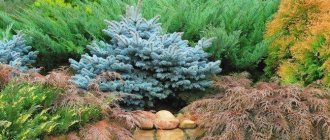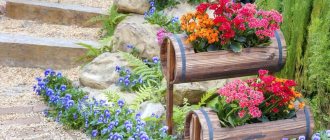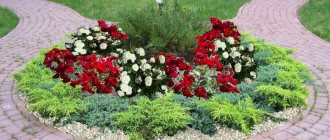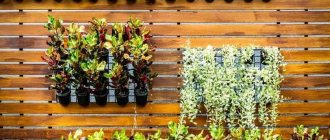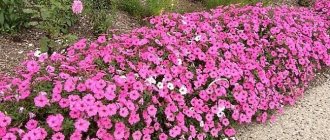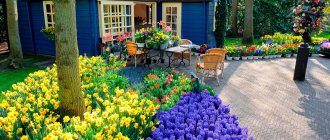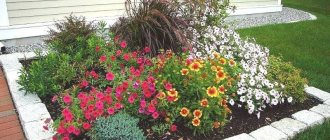LiveInternetLiveInternet
—Categories
- For children (61)
- Training (32)
- games (14)
- Educational toys (9)
- Crafts (4)
- Poems (2)
- Topiary (18)
- Sales organization (13)
- Aphorisms, quotes, proverbs, wise thoughts (3)
- Knitting (2)
- Crochet sweaters (2)
- Wedding accessories (1)
- Video (3)
- Vintage (1)
- Decor (13)
- master classes on decor (11)
- Decoupage (541)
- Inspirello (18)
- Marina Trublina (17)
- Alisa Luchinskaya (47)
- Anna Turchina (24)
- Ascetic (60)
- Bottles (5)
- vases (5)
- Video lessons (42)
- Evgenia Bazhenova (4)
- Elena Perestoronina (45)
- Imitation of various materials (36)
- Craquelure (36)
- kitchen (5)
- Marina Nikulina (15)
- Natalia Rodina (27)
- Natasha Fokhtina (34)
- Christmas balls (66)
- new year (6)
- Polish decoupage (4)
- Watches (3)
- Shabby chic (12)
- Decoupage. For inspiration (122)
- Key holders (1)
- Dressers (6)
- Watering cans (1)
- Miscellaneous (23)
- Decoupage. Materials (56)
- Decoupage. MK (157)
- Bottles (10)
- For the cottage (124)
- Home interior (9)
- gazebos (9)
- flower pots and flowerpots (5)
- Landscape design (55)
- Crafts and garden decorations (35)
- paving slabs and covering (10)
- For the kitchen (4)
- Interior (2)
- Gift ideas (15)
- from coffee (1)
- Interesting sites (9)
- interior (14)
- Pictures for decoupage miscellaneous (336)
- Africa (7)
- Curbs (6)
- Vintage (17)
- Kitchen (25)
- Bears (6)
- Men's (11)
- New Year's (67)
- Birds (3)
- Miscellaneous (82)
- Serial (14)
- Backgrounds (23)
- Floral (71)
- Cardboard boxes (64)
- mk cardboard boxes (54)
- MK matchboxes (2)
- new year (1)
- Training (5)
- English (2)
- Computer (3)
- Newspaper weaving (5)
- Repair (2)
- Scrap kits (953)
- Colors (143)
- Spring (61)
- Tender (43)
- Handicrafts (6)
- Travel (4)
- Vintage (136)
- Children's (217)
- Winter (118)
- Summer (51)
- Marine (40)
- Male (17)
- Autumn (62)
- Wedding (65)
- Scrapbooking (481)
- Albums, books (158)
- Clipart (49)
- Master class (107)
- Men's (28)
- Lettering (48)
- Cards for inspiration (35)
- passbook (12)
- Sketches (24)
- Links (15)
- Scrapbooking.Pictures for printing (194)
- Housekeeping tips (2)
- Bags (8)
- Jeans (2)
- Organizer, storage (4)
- bottle packaging (3)
- gift wrapping (15)
- bows (8)
- lesson on LiRu (38)
- Photos (68)
- photo processing (1)
- programs (13)
- Photography Lessons (26)
- photoshop (27)
- Flowers (30)
- paper flowers (20)
- braid flowers (11)
- Caskets (59)
- MK (39)
—Tags
—Search by diary
—Subscription by e-mail
-Statistics
CONIFEROUS FLOWER BED: 12 SOLUTIONS WITH DIAGRAMS
Coniferous flowerbed: 12 solutions with diagrams
Coniferous flowerbed The main coniferous plants in garden compositions are not tall conifers (pines, spruce, fir), but their compact and low-growing forms. Coniferous compositions go well with shrubs (rhododendrons, Ericas, heathers, barberries, spirea, evergreen boxwoods), herbaceous perennials (hostas, ferns, cereals). When creating a flower bed, it is necessary to plant ground cover plants in the foreground (creeping grass, awl-shaped phlox, sedums, thyme, bryozoans, etc.). Bulbs (crocuses, muscari, low-growing tulips) will bring bright colors in spring. It is very important to think about the arrangement of plants. Groups must be created according to the principle of contrast of shape and color. For example, it is good to emphasize columnar forms with spherical, dense bush and creeping forms, with different types, textures and colors of needles. The needle-like needles of junipers, spruce and pine trees go well with the scale-like needles of thuja. When selecting plants, you should check their maximum height. Coniferous compositions can only be composed of slow-growing and dwarf varietal forms.
12 options for coniferous flower beds
1.
1. Western thuja “Holmstrup” 2. Medium juniper “Old Gold” 3. Mountain pine “Mops” 4. Coastal juniper “Shlager”
What plants are combined in coniferous flower beds
Conifers can be the basic elements of a flower garden. Each species has decorative varieties of small height, acceptable for the scale of a personal plot. Suitable for this role:
- pine trees;
- ate;
- junipers;
- hemlock;
- fir trees
The following look great as decorative shrubs of the second tier:
- barberries;
- heathers;
- rhododendrons;
- spirea;
- boxwoods;
- Erica.
From herbaceous plants (both flowering and decorative foliage) you can safely take:
- ferns;
- cereals;
- phlox;
- thyme;
- sedum;
- bryozoan;
- creeping tenacious creature.
Of course, this is an incomplete list of crops for a mixed flower bed. Further, in specific diagrams and in the photo, you will see what other plants can grow together and at the same time look original.
Ready-made schemes for juniper flower beds with other flowers and plants
Chaotic placement of juniper bushes on a site does not give such a visible aesthetic effect as planting according to a special scheme. With different types of flowers, plants and other conifers, juniper bushes create unusual but very beautiful combinations. That is why planting according to special schemes is very popular among gardeners. Juniper looks most advantageous with such “neighbors” as barberry, hydrangea, spirea, thuja, hosta, as well as with various flowers and compositions in flower beds.
Ready-made options and designs for flower beds with conifers and flowers
Option 1
With the help of such a composition you can successfully beat the path leading to the gate. Splashes of juniper (F) set off bright spots of helenium (B) and cinquefoil ©. And the heavenly color of sage (D) is in harmony with knotweed (E) and phormium (A).
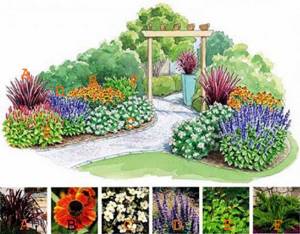
Option 2
Using this scheme you can create a very elegant mixborder. Thujas (A) of medium height are planted in the background. Buddleia Davida (B) with lilac clusters of inflorescences, purple echinacea (E), noble and delicious-smelling zinnia © will look impressive against their dark green background. Low-growing goldenrod (D) is placed in the foreground.

Option 3
With the help of such a flower bed you can create a passage to the gazebo or an exit from the site. Tall thujas (E), planted at some distance from each other, are again used as architectural plants. Tall delphinium (D) creates the second tier of the flower garden. Lower-growing lilies ©, roses (G) and asters (B), which bloom later, create a colorful carpet of flower beds. With the help of festive petunia (F) a bright accent is made in the perspective of the flowerbed. And the touching cuff (A) fills the remaining open spaces in the foreground.
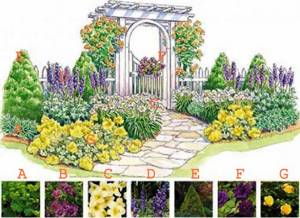
Option 4
This flower garden scheme involves the use of more types of conifers. At the same time, the decorativeness of the composition is no less than in previous versions. Due to the fact that conifers occupy a significant percentage of the area, the site does not lose its beauty even in winter.
The central part of the club is occupied by three conifers: pyramidal thuja occidentalis (A), spherical thuja (B) and horizontal juniper (C), which has a cushion-shaped dwarf shape.
The flower bed frame consists of three types of flowers: Japanese spirea (D), hybrid daylily (E) and primrose (F). A characteristic feature of these crops is that they, like conifers, are not demanding on soil, so such proximity is justified not only from an aesthetic point of view, but also from an agrotechnical one.

Juniper and conifers
Planting juniper next to other conifers is a very common practice. The main thing here is to choose the components: the quantity can be arbitrary, the only mandatory condition is the contrast of the colors of the needles and the height levels of the shrubs. When forming a flower bed or garden plot in a cascade, the cone-shaped tall subspecies of juniper bushes are planted first, and then, in descending order, medium-sized and low-growing ones.
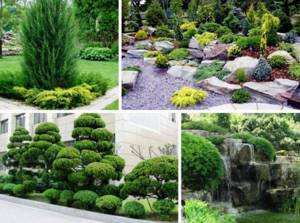
It is also possible to combine several species of juniperus, provided the soil type is suitable (if the species like different acidity of the soil, it will be quite difficult to maintain the composition in a viable state).
Conventionally, all types of layout are divided into:
- landscape (all elements are arranged in a chaotic order - flowers, bushes, trees);
- symmetrical (two or more types of fir trees with the same number of juniper bushes);
- for zoning (example: spruce, thuja, juniper).
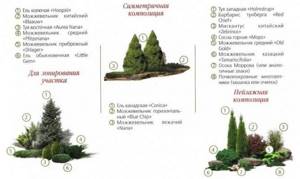
Thuja and juniper in landscape design photo
Junipers occupy a special niche in landscape design due to the richness of species with different colors of needles and crown shapes. They use both tall tree-like varieties and creeping shrubs, combining them into various design solutions.
This could be an alpine hill, a lawn border, a hedge or a coniferous flower bed.
Let us consider below the most profitable options for decorating a personal plot with conifers, as well as photos of junipers in landscape design in combination with thuja and other plants.
Photos of thujas and junipers in landscape design
Coniferous plants are widely used in landscape design to create a variety of styles and compositions. Below are photos of junipers in the garden and a design using them.
Photo of a rock garden using more than three types of juniper, as well as thuja.
Photo of landscape design of an alpine hill.
Photo of a coniferous garden with thuja and juniper.
Photo of using juniper in the garden to decorate a coniferous flower bed.
Photo of a hedge made of thuja.
Photo of a border for a flower bed of coniferous shrubs. Thujas were used for the background of the landscape design.
Photo of a flower bed, for the decoration of which several varieties of thuja were used.
Compositions of juniper with thuja
In combination with thujas, other plants, for example, Grandiflora hydrangea, can be planted near juniper bushes. Approximate layout: the Cossack variety (Danub) is planted in the center, and western thujas (Vudvari) are planted on the sides; in the background it is permissible to place cone-shaped thujas of the Smaragd subspecies with needles that are brighter than those of Vudvari.
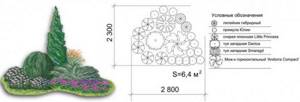
Recommended flowering plants: petunias, jasmine, daisies.
How to beautifully plant thujas on the site
Thuja is unpretentious and grows in almost any conditions: in well-lit places or partial shade, but does not like very dark and northern places. To grow a fence, use the Columna variety; thujas grow into a beautiful hedge.
To create a beautiful hedge, you should find out in advance how much the selected variety grows upward and in width; planting depends on this, so that the hedge remains beautiful even over several years.
The Smaragd variety is also excellent for creating a hedge. The distance when planting each plant is 70 cm. It should be planted a meter or one and a half meters from the fence. In three years, the thuja grows into a tall, beautiful hedge. Thuja western emerald has a regular cone-shaped crown, reaching up to 4-6 meters in height and up to 1.80 in width. This thuja is always evergreen. Grows in any soil, grows best in the sun. The soil should be moist and fertile. Already fertilized seedlings are planted in the ground. Hardy and frost-resistant. The good quality of this variety is that it does not turn yellow.
Thuja is suitable for planting together with roses. But we must take into account the rule of constructing an ensemble. If three elements are involved in planting, then the ensemble should combine no more than two colors. So, the constructed composition will look organic. If there are more colors, then the elements are combined into groups of three with the same colors.

Photo source - russcletta.com. The author is landscape designer from Italy Russ Cletta. Roses are given the foreground, conifers serve as the background.
The use of roses and conifers in landscape design is possible, but a large area must be allocated for this. Due to the extensive root system of both plants, they are planted at a distance of at least one and a half meters - this promotes the further development of the plants. It is recommended to plant thujas in a semi-shaded area, and roses in lighter and more formal areas. The rose will not look great if planted in the shade.
Juniper with hostas
Hostas with shrubs form a so-called contrasting flower garden. They usually occupy the extreme part of the diagram. Shape: circle, cascade, oval. Virginia juniper is suitable for combination with hostas, as well as Japanese astilbe, cappuccino astilbe, barberry, heucherella, and iris. Planting along the perimeter of the site with spruce and cypress trees is allowed. Recommended flowering plants: daffodils, tulips, all bulbous plants.

They usually occupy the extreme part of the diagram.
Juniper and barberry
This combination may also contain other shrubs and plants, for example, thujas or pine trees. When choosing varieties, people most often pay attention to Thunberg barberry, rocky (Skyrocket) and medium juniper (Mint Julep). The number of elements in a flower bed is usually 5, 6 or 7. Larger plant compositions are used when designing large areas. Recommended flowering plants are rhododendrons, hydrangeas, primroses.
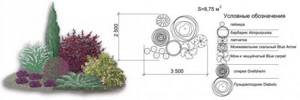
Designers recommend giving preference to dwarf barberries, for example, Arthropurpurea Nana, Harlequin, Kobold, Minor, Aurea. They have a denser crown and are characterized by slow growth.
Planting juniper: subtleties and nuances
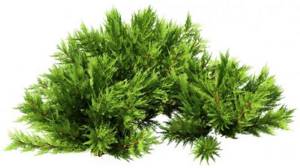
Each of the existing varieties of juniper, including Cossack, requires special conditions regarding planting. To begin with, you should pay attention to the fact that only well-lit areas are used for planting junipers, otherwise the bush will quickly lose its external luster and begin to wither. As an exception, it is worth noting the absence of a similar effect on ordinary juniper. When using large varieties of juniper, in which the bushes are classified as spreading, the distance between plants will be at least one and a half meters, while for ordinary varieties half a meter is enough. If the rule is ignored, the overgrown bushes will begin to create shadows for each other.
Juniper should not be planted in close proximity to low-growing plants, since the shadow they create will not give its neighbors a chance to survive. Juniper intensively extracts nutrients from the soil, so nearby plants will be left with nothing. Some gardeners prefer to plant juniper around the perimeter of the house or in a flower bed in front of the entrance. This way you can get something like a hedge, which, with proper care and proper pruning, will help decorate the building and protect it from gusts of wind. An interesting way to plant bushes is in a checkerboard pattern. Before planting in open ground, pots with young plants are installed for a while in those places where planting is planned in the future.
A few hours before the manipulation, the roots are saturated with a large amount of moisture; for this, the plant is placed in a container with clean, settled water. The hole is made slightly larger than the previously used container. Before planting bushes in open ground, experienced gardeners recommend digging up and fertilizing the selected area. At the bottom of the hole, drainage is installed, based on brick or sand. Its thickness will be no more than 25 cm. A bush is installed in the hole, the roots of which are sprinkled with a pre-prepared mixture based on peat, sand and turf. When using large bushes, the root collar is not compacted into the ground.
Video about planting and caring for juniper:
Rectangular high flowerbed with spirea
This type of flower bed can be presented in several variations:
- a high stone container (marble, granite) with sides, inside of which earth is poured and juniper, other conifers and spirea are planted on it;
- a structure made of stone and mesh with an earthen “cushion inside”;
- a classic rectangular flowerbed located on a hill and fenced off by a fence;
- composition along a fence or garden path.
Of course, there are plenty of options. The general rule for all such schemes is that low grades are placed at the edges, higher ones in the depths. This principle also applies to cascading garden design solutions. Varieties of spirea for combination with juniper: Nippon, gray, birch-leaved, Vangutta.

1. Thuja occidentalis “Globosa” 2. Cypress pea 3. Spiraea Boumalda “Froebelli” 4. Scaly juniper “Blue Сarpet” 5. Hybrid iris.
By following the rules for forming flower beds and landscape compositions, you can get a truly spectacular garden decoration. Designers call the best color combinations yellow-green, yellow-white, emerald-lemon, as well as combinations of pine needles with red, purple, yellow and orange flowering plants.
Schemes of flower beds with coniferous plants
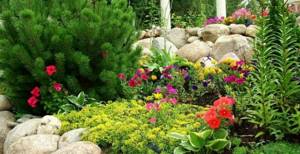
Many gardeners try to create a beautiful flower bed in their own dacha without resorting to the services of landscape designers. Of course, this not only saves money, but also has a beneficial effect on our self-esteem, and also satisfies the creative impulse of “country designers.” If you don’t have enough ideas for inspiration, I offer a selection of flower bed planting schemes using coniferous plants to help.
Flower beds of roses and conifers: diagrams
In order to plant a coniferous flowerbed in landscape design, use this composition:
- A flowerbed with a lawn or a flowerbed in the form of a slide is taken as a basis;
- The decor can be stones or bark;
- Low-growing varieties of conifers are considered priority;

Source - dacha-vprok.ru
- The first composition features the Globosa variety;
- Number two is Selena;
- In the center, number three, is a cedar pine;
- At number four, Tsuga Canadensis is planted;
- At number five, junipers, variety Tamariscifolia, are planted;
- Number six, a pine tree, the variety Pinus sylvestris, is planted.
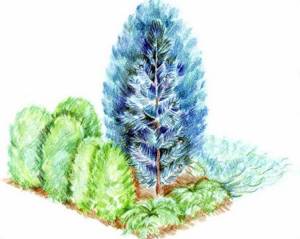
Scheme from the site dacha-vprok.ru
How to create a mixborder?
Mixborder is the creation of a flower bed in groups, where each group of plants smoothly flows into another. The flowerbed consists of three stages:
- Three-dimensional plants are planted in the background;
- Tall plants;
- Plants without lush foliage.
Next, ground-blooded roses and annual plants are planted. Decorated with stones. For a mixborder, choose a sunny or slightly shaded place.
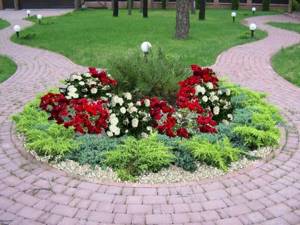
Source - landas.ru
Flowering perennial plants planted in front of the thuja will look especially advantageous; creeping thuja or horizontal juniper are planted at the very bottom of the composition.
Flowerbed with roses and conifers (diagram):

Rice. from the site idei-dlja-dachi.com
- The Winchester Cathedral rose variety is planted;
- Rose variety Lady Emma Hamilton;
- Molineux;
- William Shakespeare;
- Evergreen juniper;
- Sage is planted along the edges of the flower bed;
- Ornamental hosta plant.
In this composition, juniper will highlight the roses and make them stand out from the background of the entire flowerbed. Sage helps light varieties of roses look good. If the sage grows, it can be formed into any shape. Hosta, planted along the edge of the flowerbed, complements the created composition.
